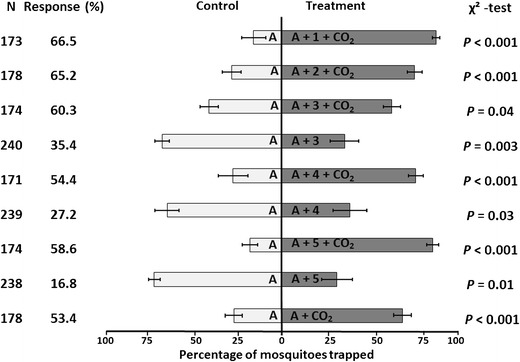Fig. 1.

Reversal of repellence to attraction of Anopheles coluzzii by butan-1-amine depending on addition of carbon dioxide. Mean percentages of released mosquitoes that were trapped with the respective odor blends. Error bars represent SEM. N is the total number of mosquitoes that were introduced in the olfactometer, six to eight groups of 30 females minus the ones that did not leave the release cage. The six to eight bioassays were performed on at least three test days. The response is the percentage that was trapped by the end of the 15-min experiment. The numbers placed inside the bars indicate the compound(s) and concentrations that were added to the basic blend consisting of NH3, (S)-lactic acid, and tetradecanoic acid. Mean percentages of mosquitoes that were trapped when exposed to the basic blend (A) augmented with butan-1-amine in five concentrations, with or without carbon dioxide. P-values are based on χ 2-tests. Data for four-component blend without carbon dioxide were taken from Smallegange et al. (2012) and reproduced here for direct comparison. A = basic blend; 1: 0.001 % butan-1-amine; 2: 0.004 %; 3: 0.01 % butan-1-amine; 4: 0.1 % butan-1-amine; 5: 1.0 % butan-1-amine
